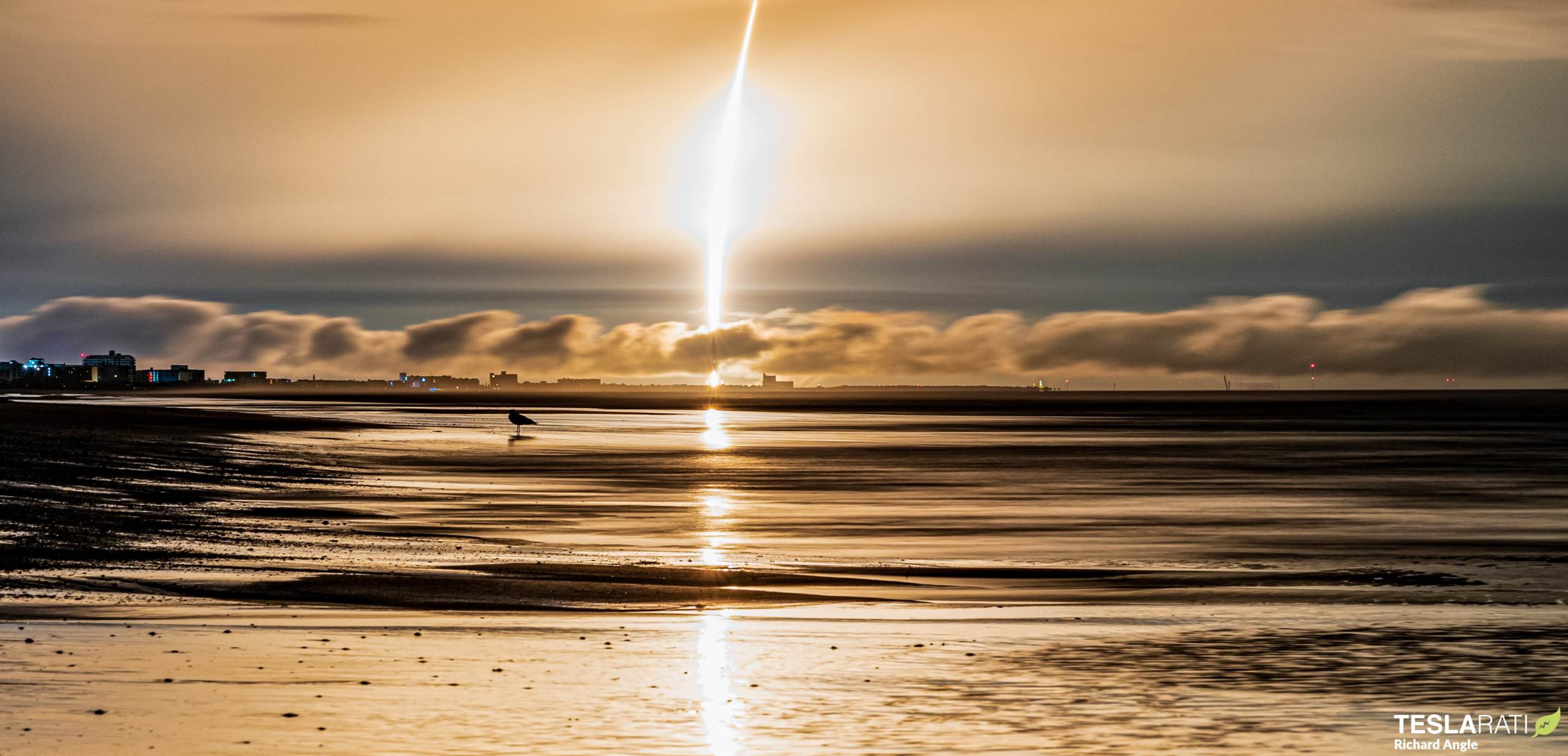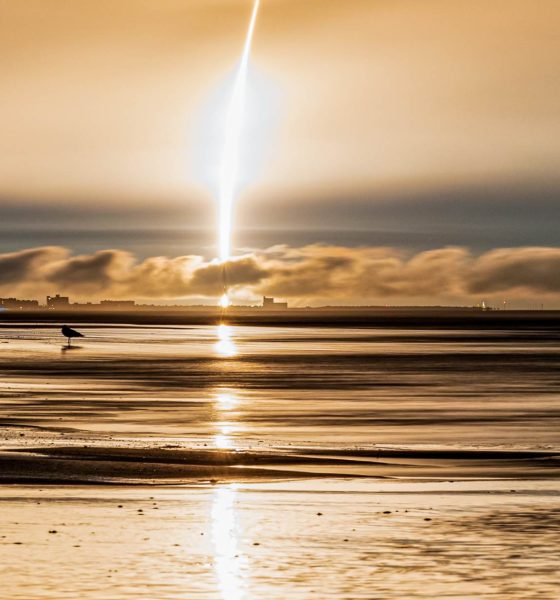

News
SpaceX Falcon 9 rocket launches heaviest payload yet
SpaceX has launched its heaviest payload yet for the third time in ten months, demonstrating that it’s still finding ways to improve the performance of its mature Falcon rockets.
At 9:30 am EST, January 25th, SpaceX completed a static fire of the two-stage Falcon 9 rocket assigned to launch its next Starlink mission. Half an hour later, SpaceX confirmed that the rocket performed well and is scheduled to launch no earlier than 4:32 am EST (09:32 UTC) on Thursday, January 26th. SpaceX didn’t state the mission’s purpose, but shorthand (“sl5-2”) used in an official website URL implied that it would be the second launch for its Starlink Gen2 satellite constellation.
Flying for the ninth time, Falcon 9 booster B1067 lifted off on schedule and sent an expendable Falcon upper stage and Starlink 5-2’s 56-satellite payload on their way to space. B1067 safely touched down on a SpaceX drone ship soon after, setting it up to reach double digits later this year. The bus-sized stack of satellites was deployed in orbit soon after, completing SpaceX’s 176th consecutively successful launch since January 2017.
The update that's rolling out to the fleet makes full use of the front and rear steering travel to minimize turning circle. In this case a reduction of 1.6 feet just over the air— Wes (@wmorrill3) April 16, 2024
Eleven Teslas to orbit
56 is not an unprecedented number of satellites for a SpaceX launch or a Starlink launch. SpaceX has launched a record 143 rideshare payloads at once, and the company routinely launched 60 Starlink satellites at a time throughout 2019, 2020, and half of 2021. But those Starlink satellites were the first versions (V0.9-V1.0) of the spacecraft and weighed either 227 or 260 kilograms (500/570 lbs) apiece.
In the second half of 2021, SpaceX began launching new Starlink V1.5 satellites. Outfitted with laser links (optical terminals) and other miscellaneous upgrades, the new satellites weigh either 303, 307, or 309 kilograms (668, 676, or 681 lb) each. The heavier design forced SpaceX to slightly reduce the number of satellites each launch could carry. After some optimization, SpaceX regularly launches up to 54 Starlink V1.5 satellites per rocket, down from 60 V1.0 satellites.
The number of satellites may be smaller, but the mass of the payload launched has never been higher. SpaceX last broke Falcon 9’s payload mass record in August 2022, when it launched 54 Starlink V1.5 satellites for the first time. The payload reportedly weighed 16.7 tons (~36,800 lb), breaking the previous record of 16.25 tons by about 3%. The heaviest 60-satellite Starlink V1.0 payload weighed ~15.6 tons (~34,400 lb).

Now, Falcon 9 has launched 56 Starlink V1.5 satellites at once. SpaceX says the payload weighed 17.4 tons (~38,400 lb), crushing the company’s previous record of 16.7 tons. 17.4 tons is just shy of the weight of 11 Tesla Model 3s.
Starlink 5-2 targeted the same orbit as Starlink 5-1, which carried 54 satellites, indicating that SpaceX has likely made another iterative improvement to Falcon 9 performance. As SpaceX has gained confidence in and experience with Falcon 9, it’s been able to tweak the timing of certain launch events, raise performance limits, and reduce margins throughout the rocket. Starlink 5-2’s record payload means that SpaceX’s tweaks have collectively boosted Falcon 9’s performance by 11.5% (15.6 to 17.4 tons) in just a few years.
Gen1, V1.0, V1.5, Gen2, V2.0
Starlink 5-2 continues a trend of confusion begun by the company’s first Starlink Gen2 launch, which it deemed Starlink 5-1. The naming scheme implied that the satellites were a continuation of the company’s first constellation, Starlink Gen1, but SpaceX confirmed that they were the first Starlink Gen2 satellites. That SpaceX is launching 54 (and now 56) satellites also confirms that they are likely the same V1.5 satellites the company has been launching for 18 months.
SpaceX CEO Elon Musk has outright stated that the company could go bankrupt if it couldn’t begin launching much larger Starlink V2.0 satellites on its Starship rocket in the near future. Instead, SpaceX is doing the exact opposite and is populating its Starlink Gen2 constellation with Gen1-sized satellites. It’s unclear when SpaceX will begin launching the larger Starlink V2.0 satellites that were meant to be the mainstay of the Gen2 constellation.
Rewatch SpaceX’s second Starlink Gen2 launch below.

Elon Musk
Elon Musk’s X will start using a Tesla-like software update strategy
The initiative seems designed to accelerate updates to the social media platform, while maintaining maximum transparency.

Elon Musk’s social media platform X will adopt a Tesla-esque approach to software updates for its algorithm.
The initiative seems designed to accelerate updates to the social media platform, while maintaining maximum transparency.
X’s updates to its updates
As per Musk in a post on X, the social media company will be making a new algorithm to determine what organic and advertising posts are recommended to users. These updates would then be repeated every four weeks.
“We will make the new 𝕏 algorithm, including all code used to determine what organic and advertising posts are recommended to users, open source in 7 days. This will be repeated every 4 weeks, with comprehensive developer notes, to help you understand what changed,” Musk wrote in his post.
The initiative somewhat mirrors Tesla’s over-the-air update model, where vehicle software is regularly refined and pushed to users with detailed release notes. This should allow users to better understand the details of X’s every update and foster a healthy feedback loop for the social media platform.
xAI and X
X, formerly Twitter, has been acquired by Elon Musk’s artificial intelligence startup, xAI last year. Since then, xAI has seen a rapid rise in valuation. Following the company’s the company’s upsized $20 billion Series E funding round, estimates now suggest that xAI is worth tens about $230 to $235 billion. That’s several times larger than Tesla when Elon Musk received his controversial 2018 CEO Performance Award.
As per xAI, the Series E funding round attracted a diverse group of investors, including Valor Equity Partners, Stepstone Group, Fidelity Management & Research Company, Qatar Investment Authority, MGX, and Baron Capital Group, among others. Strategic partners NVIDIA and Cisco Investments also continued support for building the world’s largest GPU clusters.
News
Tesla FSD Supervised wins MotorTrend’s Best Driver Assistance Award
The decision marks a notable reversal for the publication from prior years, with judges citing major real-world improvements that pushed Tesla’s latest FSD software ahead of every competing ADAS system.

Tesla’s Full Self-Driving (Supervised) system has been named the best driver-assistance technology on the market, earning top honors at the 2026 MotorTrend Best Tech Awards.
The decision marks a notable reversal for the publication from prior years, with judges citing major real-world improvements that pushed Tesla’s latest FSD software ahead of every competing ADAS system. And it wasn’t even close.
MotorTrend reverses course
MotorTrend awarded Tesla FSD (Supervised) its 2026 Best Tech Driver Assistance title after extensive testing of the latest v14 software. The publication acknowledged that it had previously criticized earlier versions of FSD for erratic behavior and near-miss incidents, ultimately favoring rivals such as GM’s Super Cruise in earlier evaluations.
According to MotorTrend, the newest iteration of FSD resolved many of those shortcomings. Testers said v14 showed far smoother behavior in complex urban scenarios, including unprotected left turns, traffic circles, emergency vehicles, and dense city streets. While the system still requires constant driver supervision, judges concluded that no other advanced driver-assistance system currently matches its breadth of capability.
Unlike rival systems that rely on combinations of cameras, radar, lidar, and mapped highways, Tesla’s FSD operates using a camera-only approach and is capable of driving on city streets, rural roads, and freeways. MotorTrend stated that pure utility, the ability to handle nearly all road types, ultimately separated FSD from competitors like Ford BlueCruise, GM Super Cruise, and BMW’s Highway Assistant.
High cost and high capability
MotorTrend also addressed FSD’s pricing, which remains significantly higher than rival systems. Tesla currently charges $8,000 for a one-time purchase or $99 per month for a subscription, compared with far lower upfront and subscription costs from other automakers. The publication noted that the premium is justified given FSD’s unmatched scope and continuous software evolution.
Safety remained a central focus of the evaluation. While testers reported collision-free operation over thousands of miles, they noted ongoing concerns around FSD’s configurable driving modes, including options that allow aggressive driving and speeds beyond posted limits. MotorTrend emphasized that, like all Level 2 systems, FSD still depends on a fully attentive human driver at all times.
Despite those caveats, the publication concluded that Tesla’s rapid software progress fundamentally reshaped the competitive landscape. For drivers seeking the most capable hands-on driver-assistance system available today, MotorTrend concluded Tesla FSD (Supervised) now stands alone at the top.
News
Elon Musk’s Grokipedia surges to 5.6M articles, almost 79% of English Wikipedia
The explosive growth marks a major milestone for the AI-powered online encyclopedia, which was launched by Elon Musk’s xAI just months ago.

Elon Musk’s Grokipedia has grown to an impressive 5,615,201 articles as of today, closing in on 79% of the English Wikipedia’s current total of 7,119,376 articles.
The explosive growth marks a major milestone for the AI-powered online encyclopedia, which was launched by Elon Musk’s xAI just months ago. Needless to say, it would only be a matter of time before Grokipedia exceeds English Wikipedia in sheer volume.
Grokipedia’s rapid growth
xAI’s vision for Grokipedia emphasizes neutrality, while Grok’s reasoning capabilities allow for fast drafting and fact-checking. When Elon Musk announced the initiative in late September 2025, he noted that Grokipedia would be an improvement to Wikipedia because it would be designed to avoid bias.
At the time, Musk noted that Grokipedia “is a necessary step towards the xAI goal of understanding the Universe.”
Grokipedia was launched in late October, and while xAI was careful to list it only as Version 0.1 at the time, the online encyclopedia immediately earned praise. Wikipedia co-founder Larry Sanger highlighted the project’s innovative approach, noting how it leverages AI to fill knowledge gaps and enable rapid updates. Netizens also observed how Grokipedia tends to present articles in a more objective manner compared to Wikipedia, which is edited by humans.
Elon Musk’s ambitious plans
With 5,615,201 total articles, Grokipedia has now grown to almost 79% of English Wikipedia’s article base. This is incredibly quick, though Grokipedia remains text-only for now. xAI, for its part, has now updated the online encyclopedia’s iteration to v0.2.
Elon Musk has shared bold ideas for Grokipedia, including sending a record of the entire knowledge base to space as part of xAI’s mission to preserve and expand human understanding. At some point, Musk stated that Grokipedia will be renamed to Encyclopedia Galactica, and it will be sent to the cosmos.
“When Grokipedia is good enough (long way to go), we will change the name to Encyclopedia Galactica. It will be an open source distillation of all knowledge, including audio, images and video. Join xAI to help build the sci-fi version of the Library of Alexandria!” Musk wrote, adding in a later post that “Copies will be etched in stone and sent to the Moon, Mars and beyond. This time, it will not be lost.”








